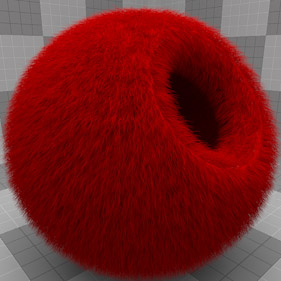
Endless fields of well manicured lawns, small woodland creatures, shag carpeting and werewolves - what do these all have in common? Why of course they are all possible with modo's fur material. This flexible texture layer covers surfaces with all manner of fuzzy, frazzled, fluffy, fibrous fur. The various functions provided should allow for a great range of creative options, including the ability to recreate tame or wild lawns, all manner of fibrous carpeting, little fuzzy animals, maybe even cover a conifer with pine needles. Best part is, modo still renders all of these fibers with amazing speed, even when using global illumination.
Applying Fur to a surface begins with adding a 'Fur Material item to the to the target surface in the Surface viewport. For information regarding adding and working with Shader Item Layers, please reference the Shaders page of the documentation. Also, there is a 'Working with Fur' page that covers additional information regarding the use of fur in modo.
 Once a fur layer is added, the first thing users may notice are the lines extending from the target object or surface. They may be long or short depending on the objects relative scale, don't worry though as they can be adjusted. Users can't select these lines directly, they're only meant to be a rough preview, representing the fibers now growing from the surface. As users make changes in the material properties, the guides update in real time in the viewport providing useful feedback on the various parameters. There are a number of options available in the properties panel that are broken into multiple sub-tabs, the 'Fur Material', where you specify the settings for the fibers density, size and shape as well as how they render, the second tab, the 'Fur Shape' controls where you adjust the fibers themselves, if they are curly or straight, wavy or limp and finally the third tab 'Fur Kink' where the Frizz and Kink values are defined. There are also options to control your fur with guides that can be styled with modo's painting tools (covered on the 'Working with Fur' page).
Once a fur layer is added, the first thing users may notice are the lines extending from the target object or surface. They may be long or short depending on the objects relative scale, don't worry though as they can be adjusted. Users can't select these lines directly, they're only meant to be a rough preview, representing the fibers now growing from the surface. As users make changes in the material properties, the guides update in real time in the viewport providing useful feedback on the various parameters. There are a number of options available in the properties panel that are broken into multiple sub-tabs, the 'Fur Material', where you specify the settings for the fibers density, size and shape as well as how they render, the second tab, the 'Fur Shape' controls where you adjust the fibers themselves, if they are curly or straight, wavy or limp and finally the third tab 'Fur Kink' where the Frizz and Kink values are defined. There are also options to control your fur with guides that can be styled with modo's painting tools (covered on the 'Working with Fur' page).
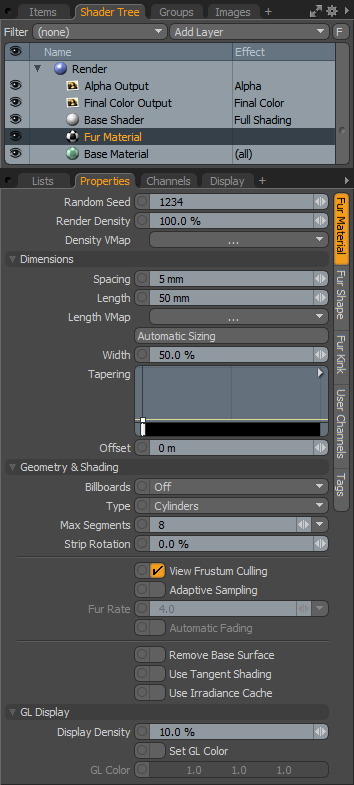 Random Seed: The 'Random Seed' value is an initial setting used when generating random numbers. Different values will produce different random variations, however you will want to use the same 'Seed' value when it is necessary that items retain the same variations.
Random Seed: The 'Random Seed' value is an initial setting used when generating random numbers. Different values will produce different random variations, however you will want to use the same 'Seed' value when it is necessary that items retain the same variations.
Render Density: The 'Render Density settings allows the user to easily adjust the density or overall number of fibers on the surface, increasing this value will increase the number of fibers creating a thicker matte, while lower values will thin the number of overall fibers. This only affects the number of fibers that are rendered. Keep in mind that increased numbers of fibers will require more memory to calculate and take longer to render.
Density VMap: Users can create an embedded Weight Map on the target fur surface and use its values to control the Density (thickness) of the Fir fibers across the surface eliminating the need to create custom image maps. Any available Weight Maps can be selected from this dropdown controlling the final density of the resulting fur. Weight Map values work as a multiplier over the normal rendered density, with values of 1 producing the unmodified 100% density fading toward 0 producing 0% density.
Dimensions--
Spacing: The 'Spacing' value sets the average space between individual fibers. Smaller values will result in thicker, more dense fur, while larger values result in thinner fur. This setting works in tandem with the 'Width' percentage in specifying the thickness of the fiber itself.
Length: The 'Length' value sets the overall length of the fibers from their root to their tip.
Length VMap: Users can create an embedded Weight Map on the target fur surface and use its values to control the Length of the Fir fibers across the surface eliminating the need to create custom image maps. Any available Weight Maps can be selected from this dropdown controlling the final length of the resulting fur. Weight Map values work as a multiplier over the normal rendered length, with values of 1 producing the unmodified 100% length fading toward 0 producing 0% length.
Automatic Sizing: The 'Automatic Sizing' command will set an initial value for your furs spacing, and length based on the size of the fur surfaces bounding box. Calculated as the spacing of 0.5% percent of the surface bounding box maximum extent, (the maximum length of the bounding box diagonals). The fur length is then 10 times that value. This should only be considered a starting point.
Width: The 'Width' amount sets the width or thickness of the individual fibers at their root. It is a percentage of the Spacing value, So lets say if you have a spacing of 10mm and the Width is set to 10%, the fibers would then be 1 mm wide at the root; 50% would make them 5 mm and so on.
Tapering: The 'Tapering' control allows users to modify the width of the individual fibers along their length. Using a mini-gradient input, the width can be modified with gradient keys that represent a percentage of the original fibers width. Much like how a keyframe defines a value in time, these keys represent a value along the length allowing for fibers that can grow and shrink in width any number of times along their length. The gradient input's width represent the individual fibers overall length, with the base on the left side. Keys can be added by MMB+clicking along the length of the gradient input and then LMB+click and drag the key icon up or down adjusting the value. The grayscale bar directly below gives visual feedback as to how the values fade from one key to the next, black will produce the fiber at its full defined width and white will taper the width to 0% (no width), with the shades of gray attenuating the fiber in between. Keep in mind that complex tapering input will also require additional geometry to render correctly, so increasing the number of segments will be necessary in those cases (in-turn also increasing the amount of RAM required to render the scene).
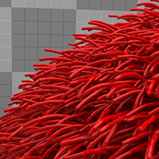 Linear Taper No Key | 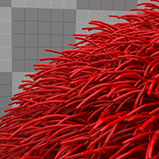 Linear Taper 25% key | 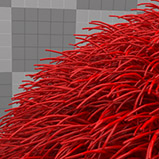 Linear Taper 57% key | 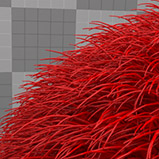 Linear Taper 75% key | 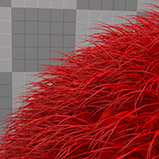 Linear Taper 100% key |
Offset: The 'Offset' value pushes the root of the fibers away from the surface the specified distance. Fibers will retain their overall length.
Geometry and Shading--
Billboards: The 'Billboards' option provides users an easy way to set up billboard polygons, distributing flat simple polygon planes across a surface. When images are mapped to the planes, it can easily be made to look more complex than their shape would suggest. Generally, the Billboard setting is set to 'Off' and has no effect on the fibers. When set to the other options, their setting override to 'Type', 'Taper' and other settings providing one-click setup of these popular functions.
Off- Disables the billboard option.
Trees- Replaces each fiber with a flat, upright simple polygon plane that always faces the current render camera.
Leaves- Replaces each fiber with a flat simple polygon plane.
Type: The 'Type' drop down allows the user to specify the method modo uses to generate the fur fibers. 'Cylinders' are like tiny tubes, great for fur and hair, while 'Strips' are flat planes, these are great for making grass among other thing.
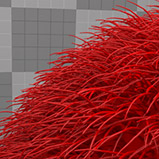 Type Cylinder | 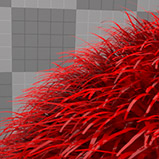 Type Strip |
Max Segments: Just like how a curved surface requires more polygons to produce a smooth effect, increasing the 'Max Segments' will produce smoother curves to generated fibers, but setting this value too high can result in an increase in memory usage and processing time required to calculate the fur layer. You can get away with using fewer segments on fibers that bends only slightly, however long or curly hair will likely require more segments to produce a smooth result.
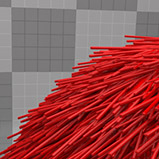 Segments 1 | 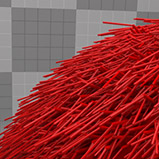 Segments 2 | 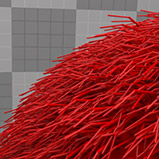 Segments 3 | 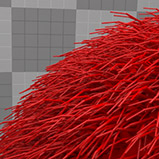 Segments 4 | 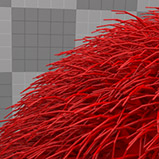 Segments 5 |
Strip Rotation: This option is only effective when 'Type > Strip' is selected, as the 'Strip Rotation' value will randomly rotate individual fibers at their root. Increasing the value will increase the amount of rotation applied, up to 180 degrees at 100%. You can also change the direction using 'Jitter Direction' in the Fur Shape tab, the difference is that Strip Rotation will retain the same bend direction while Direction Jitter does not.
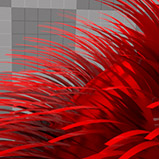 Strip Rotation 0% | 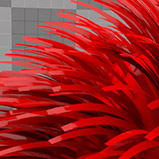 Strip Rotation 25% | 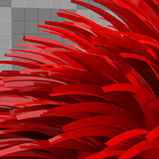 Strip Rotation 50% | 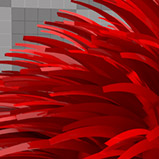 Strip Rotation 75% | 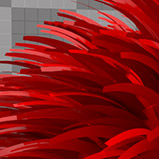 Strip Rotation 100% |
View Frustrum Culling: Enabling 'View Frustrum Culling' completely removes fur outside the view of the camera. Overall this results in faster fur generation time and reduced memory usage. It is especially useful on large landscapes covered with grass where a great deal of the fibers fall outside of the cameras view.
Adaptive Sampling: Enabling 'Adaptive Sampling' will decrease the density of a fur layer as it recedes away from the camera as based on the 'Fur Rate', reducing the overall memory required to calculate. To avoid popping as fibers disappear, enable 'Automatic Fading'.
Fur Rate: The 'Fur Rate' specifies the threshold that 'Adaptive Sampling' uses to reduce fibers, calculated as an average distance, in pixels, between two fibers. Adaptive Sampling and Fur Rate are best used on scenes like grassy fields or any situation where large amounts of fibers recede into the distance
Automatic Fading: 'Automatic Fading' works with 'Adaptive Sampling' by fading fibers in and out when they are created\destroyed by 'Adaptive Sampling'. This is ideal for animated sequences, the caveat being that render times will increase as semi transparent geometry takes longer to render.
Remove Base Surface: Fur takes it's color and shading information from the material of the surface the fur grows from. Therefore you end up with a green polygon with green fur growing from it. 'Remove Base Shader' will make that base polygon invisible, like setting the Dissolve Amount to 100%. You more than likely want the grass shading to be different than that of the surface it's attached to, That can be accomplished pretty easily too, look for more detail on that in the 'Working with Fur' page.
Use Tangent Shading: When 'Use Tangent Shading' is enabled, the specular shading normal is rotated toward the camera creating highlights that run parallel to the fur direction providing an overall more realistic 'hair' type highlight.
Use Irradiance Cache: While the Irradiance Caching options for rendering are quite fast, when rendering fur they can be come quite slow, because of the high number of curved surfaces in close proximity. So by default modo now uses the Monte Carlo method of Calculating Global Illumination on just Fur overriding the GI settings of the 'Render' item. Still in some special cases, users may wish to use Irradiance Caching instead, enable this option to do so.
GL Display--
Display Density: In order to speed up the onscreen display, you may wish to view a fewer number of fibers than what will render. The 'Display Density' only affects the number of preview fibers displayed in the 3D viewport.
Set GL Color: When this toggle is enabled, users can use the 'GL Color' option to set the color for the display of the guide hairs visible in the 3D GL viewport. This option is useful in helping to differentiate fibers from other scene elements visually differentiating them from the rest of the scene.
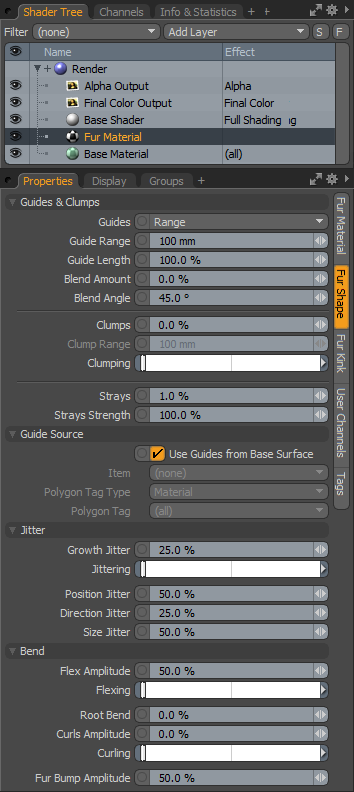 Guides and Clumps--
Guides and Clumps--
Guides: Guides are drawn curves (geometry) that can be used to style the fur, controlling length and direction among other attributes. Curves used for Fur can be created a number of ways. There's more on that on the 'Working With Fur' page as well as on the 'Styling Fur' page of the Sculpting and Painting section. The 'Guides' drop down menu allows the user to choose how Guides will affect the generated fur material--
None-- Guides have no affect on the fur texture, rendering is entirely based on the Fur Materials settings.
Clump-- Guides will be used for clumping. Based on the 'Clumps' percentage, fiber tips will clump or gather toward the guides.
Direction-- Guides will influence the fibers root direction.
Direction+Length-- Guides will influence the fibers root direction and the Fur Length setting works with guide length acting as a multiplier to define the final length. In other words, the length parameter still controls the maximum length, but the guides can control overall variations in length; shorted guides equal shorter fur.
Shape-- Fur will follow the overall shape of the guides.
Range-- With Range selected, the guides basically control fur growth directly. Working with Guide Range and Length, and the Blend settings, you can control the fur for long hair, specialized styling and specific fur rendering effects, such as braids.
Guide Range: When the Guide type is set to 'Range', the 'Guide Range' value sets the effective area around the root of the guide where fibers will be generated. When 'Guide Ranges' overlap, fibers will blend fibers between the two guides based on the blend amount. There is also a small amount of falloff around the guide range border.
Guide Length: The 'Guide Length' setting allows the user to adjust the length of fur generated by guides without the need to edit the guides themselves. A value of 100% would equal the overall guide length, while lower values will reduce the length the appropriate percentage amount.
Blend Amount: When the Guide Range setting creates areas of overlapping fibers, the 'Blend Amount' controls to what degree fibers generated between guides will blend between the two guides positions.
Blend Angle: The 'Blend Angle' sets the maximum angle between two adjoining guides that will create a blend of fibers.
Clumps: When the tips of fibers gather in small groups, it is referred to as clumping. With the guide type set to 'Clump', the greater the value set for Clumps, the more the tips of fibers will tend toward the guides. When there are no guides, the 'Clump Range' setting will determine the area of fibers that will clump together based on the 'Clumps' setting. Higher values will bring the tips into tighter groups while lower values will have less of an effect.
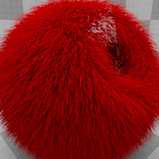 Fur Clumps 0% | 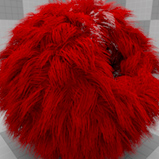 Fur Clumps 25% | 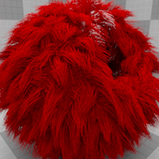 Fur Clumps 50% |  Fur Clumps 75% | 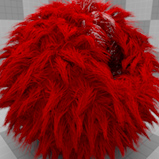 Fur Clumps 100% |
Clump Range: The 'Clump Range' sets the average range or area of fibers that will gather together based on the 'Clumps' setting.
Clumping: The 'Clumping' control allows users to influence the clumping amount along the clumps length. Using a mini-gradient input, the clumping amount can be modified with gradient keys that represent a percentage of clumping. Much like how a keyframe defines a value in time, these keys represent a clumping amount along the clumps overall length allowing for finer control. The gradient input's width represent the clumps overall length, with the base on the left side. Keys can be added by MMB+clicking along the length of the gradient input and then LMB+click and drag the key icon up or down adjusting the value. The grayscale bar directly below gives visual feedback as to how the values fade from one key to the next, black will produce no clumps, and white will produce maximum clumping, with the shades of gray attenuating the clumping in between. Keep in mind that complex clumping input will also require additional geometry to render correctly, so increasing the number of segments will be necessary in those cases (in-turn also increasing the amount of RAM required to render the scene).
Strays: The 'Strays' option randomizes a user specified percentage of individual fibers to produce a more realistic, random look to fur generated using guides. The 'Strays' option also applies to fur with 'Clumping' (otherwise this setting produces no results). Users can specify the number of fibers affected as a percentage of all fibers, defining the number of fur fibers that will be affected by the 'Strays Strength' value.
Strays Strength: The Stray Strength values determines the amount of randomization applied to the fibers chosen as strays defined as a perlin noise function that deviates the fiber along its length away from the guide. In the case of 'Clumps' this value determines the strength a fiber strays away from the clump group.
Guide Source--
Guides meant to control styling (both combing and length) of fur can be specified by polygon tag and by object. This makes it possible to separate the guides from the surface on which hairs are grown, so users can have a mesh with just the guides controlling the hairs growing on another mesh. Users can also tag the guides for each fur layer which should allow more sophisticated hair styling. Tags can be applied to guides by selecting the curves in 'Polygons' mode and applying the tags same as applying a standard polygon tag.
Use Guides From Base Surface: When this option is enabled, modo will use the guides associated with the surface from which the fur is growing (where guides and polygons are sharing a material tag). When disabled, users can specify specifically tagged guides to control the styling the fur layer. When this option is disabled (toggled off), the next three option become enabled.
Item: When 'Use Guides form Base Surface" is disabled, users can define a guide layer by selecting an 'Item' (layer) that contains guides.
Polygon Tag Type: When 'Use Guides from Base Surface" is disabled, users may select guides based on modo's various polygon tags. Working in the same way users can define surface masks based on modo's polygon tags covered in the 'Material Group' items documentation. Creation of tags is covered in the 'Defining Polygon Tags' page. Once a tag type is determined, users can use the 'Polygon Tag' option to set the particular defined tag name, instructing the Fur material to use the curves tagged as such.
Jitter--
Growth Jitter: The 'Growth Jitter' setting will increase the randomness of a fiber along its length. A setting of 0% will produce straight fibers, while increasing values will produce increasing jagged and random fibers.
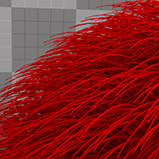 Growth Jitter 0% | 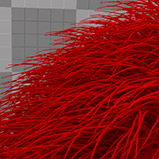 Growth Jitter 25% | 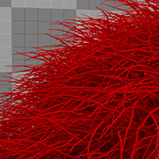 Growth Jitter 50% | 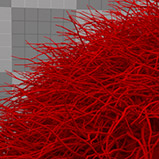 Growth Jitter 75% | 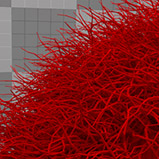 Growth Jitter 100% |
Jittering: The 'Jittering' control allows users to modulate the jitter strength along the individual fibers length (acting as a multiplier of the 'Growth Jitter' value). Using a mini-gradient input, the jittering strength can be modified with gradient keys that represent the amount of jittering. Much like how a keyframe defines a value in time, these keys represent the jittering strength along the fibers length allowing for finer control. The gradient input's width represent the length of the fiber, with the base on the left side. Keys can be added by MMB+clicking along the length of the gradient input and then LMB+click and drag the key icon up or down adjusting the value. The grayscale bar directly below gives visual feedback as to how the values fade from one key to the next, black will produce no jittering, and white will produce maximum jittering (based on the 'Growth Jitter' value), with the shades of gray attenuating the jittering in between. Keep in mind that jittering creates complex fiber twisting which will require additional geometry to render correctly, so increasing the number of segments will be necessary in those cases (in-turn also increasing the amount of RAM required to render the scene). Additionally, since 'Jittering' is a multiplier of the 'Growth Jitter' amount, a value above 0 is required before 'Jittering' will produce results.
Position Jitter: The 'Position Jitter' setting will increase the randomness of the root positions of fibers. When creating multi-layered fur, subsequent fiber layer will grow from identical positions. If this is not the intended result, you can increase the "Position Jitter' to eliminate the overlap.
Direction Jitter: The 'Direction Jitter' setting will randomize the angle of rotation for the root of a fiber. Similar to 'Strip Rotation', however 'Direction Jitter' will also randomize a fibers bend direction. A setting of 0% will produce fibers in a uniform direction, values above 0% will increase the randomness of rotations for each fiber.
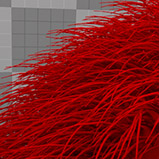 Direction Jitter 0% | 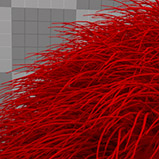 Direction Jitter 25% | 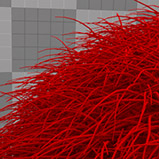 Direction Jitter 50% | 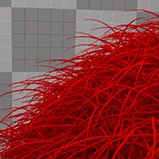 Direction Jitter 75% |  Direction Jitter 100% |
Size Jitter: The 'Size Jitter' setting will randomize the overall scale of each fiber. A setting of 0% will produce fibers of equal size, values above 0% will increase the random scaling of fibers.
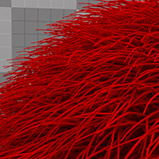 Size Jitter 0% | 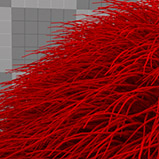 Size Jitter 25% | 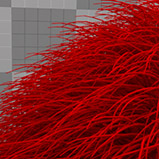 Size Jitter 50% | 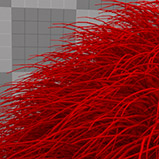 Size Jitter 75% | 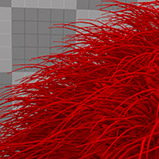 Size Jitter 100% |
Bend--
Flex: The 'Flex' setting adds bending or drooping to individual fibers as if affected by gravity. For fibers growing straight up, like grass, a value of 0% would produce perfectly straight fibers, while a setting of 100% would produce a fiber tip that is bent a full 180° from its root. Fibers growing downward would be less affected by this setting. In order to produce smooth bend results, it may be necessary to increase the number of 'Segments'.
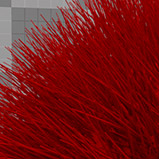 Flex 0% | 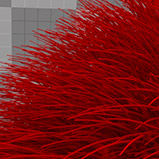 Flex 25% | 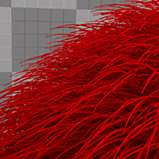 Flex 50% | 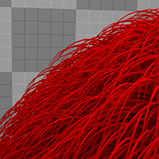 Flex 75% | 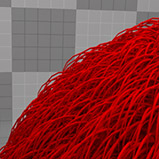 Flex 100% |
Flexing: The 'Flexing' control allows users to modulate the Flex strength along the individual fibers length (acting as a multiplier of the 'Flex' value). Using a mini-gradient input, the Flexing strength can be modified with gradient keys that represent the amount of Flex. Much like how a keyframe defines a value in time, these keys represent the Flex strength along the fibers length allowing for finer control. The gradient input's width represent the length of the fiber, with the base on the left side. Keys can be added by MMB+clicking along the length of the gradient input and then LMB+click and drag the key icon up or down adjusting the value. The grayscale bar directly below gives visual feedback as to how the values fade from one key to the next, black will produce no Flex, and white will produce maximum Flex (based on the 'Flex' value), with the shades of gray attenuating the Flexing in between. Keep in mind that 'Flexing' is a multiplier of the 'Flex' amount, a value above 0 is required before 'Flexing' will produce results.
Root Bend: With a "Root Bend' value of 0%, the root direction for a fiber is based on the direction of the corresponding smoothed polygon normal, simply stated this means whatever direction a polygon is facing, the fiber will grow from that surface in the same direction. Increasing this value will rotate the root, altering the growth direction for the fiber. A setting of 100% would produce a fiber that grows perpendicular to the normal, a rotation of 90 degrees.
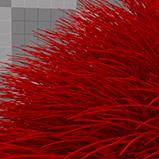 Root Bend 0% | 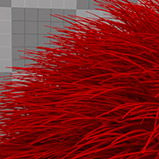 Root Bend 25% | 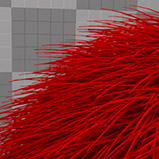 Root Bend 50% |  Root Bend 75% | 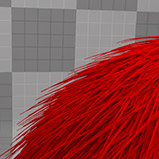 Root Bend100% |
Curls: Increasing the 'Curls' setting will add corkscrew type swirl to fibers. Small values will appear as if fiber are slightly wavy, while greater values will increase the effect creating tight overlapping swirls.
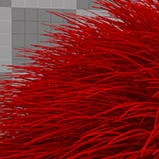 Curls 0% | 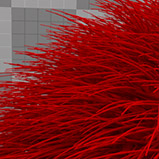 Curls 25% | 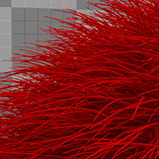 Curls 50% | 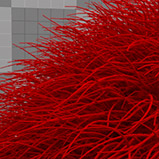 Curls 75% | 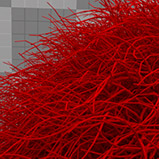 Curls 100% |
Curling: The 'Curling' control allows users to modulate the Curls strength along the individual fibers length (acting as a multiplier of the 'Curl' value). Using a mini-gradient input, the Curling strength can be modified with gradient keys that represent the amount of Curl. Much like how a keyframe defines a value in time, these keys represent the Curl strength along the fibers length allowing for finer control. The gradient input's width represent the length of the fiber, with the base on the left side. Keys can be added by MMB+clicking along the length of the gradient input and then LMB+click and drag the key icon up or down adjusting the value. The grayscale bar directly below gives visual feedback as to how the values fade from one key to the next, black will produce no Curl, and white will produce maximum Curl (based on the 'Curls' value), with the shades of gray attenuating the Curling in between. Keep in mind that 'Curling' is a multiplier of the 'Curls' amount, a value above 0 is required before 'Curling' will produce results. Additionally, note that Curling creates complex fiber twisting which will require additional geometry to render correctly, so increasing the number of segments will be necessary in those cases (in-turn also increasing the amount of RAM required to render the scene).
Fur Bump Amplitude: The 'Fur Bump Amplitude' setting controls the strength of influence a texture layer assigned to the layer effect 'Fur Bump' has over the 'Root Bend' and 'Flex' direction of the fur, effectively controlling the growth direction. Similar in function to the Fur Direction controller used for combing fur, however a Fur Bump layer can be an arbitrary image map or procedural texture, controlling the direction much like a bump map perturbs the surface rays simulating bumpy surfaces.
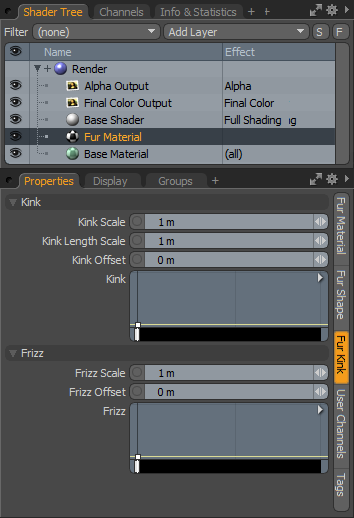 Kink--
Kink--
Based on a noise modifier, the Kink effect will apply a chaotic twisting to the individual fibers, making them look what would be described as 'Tangled'. The detail introduced is dependent on the number of segments in the fiber, higher segments will produce more detailed results, but also require additional memory and time to render. To produce a result, some value of 'Kink' along the gradient must be present.
Kink Scale: The 'Kink Scale' value determines the size of the noise that produces the kinks. Smaller values will have a more dramatic tangled look, and larger values will look less tangled.
Kink Length Scale: The 'Kink Length Scale' determines the scale of the Kink along the length of the individual fiber, large values can be made to look more like waves.
Kink Offset: The 'Kink Offset' value can be used to animate the noise, for example to simulate a grass field blowing in the wind.
Kink: The 'Kink' control allows users to modulate the Kink amount along the individual fibers length. Using a mini-gradient input, the Kink amount can be modified with gradient keys. Much like how a keyframe defines a value in time, these keys represent the Kink amount along the fibers length allowing for finer control. The gradient input's width represent the length of the fiber, with the base on the left side. Keys can be added by MMB+clicking along the length of the gradient input and then LMB+click and drag the key icon up or down adjusting the value. The grayscale bar directly below gives visual feedback as to how the values fade from one key to the next, black will produce no Kink, and white will produce maximum Kink (based on the 'Kink Scale', 'Length' and 'Offset' values), with the shades of gray attenuating the Kinking in between. Note that Kink creates complex fiber twisting which will require additional geometry to render correctly, so increasing the number of segments will be necessary in those cases (in-turn also increasing the amount of RAM required to render the scene).
Frizz--
The Frizz effect will apply a somewhat random waviness to the individual fibers, making them look what would be described as 'Messy'. The detail introduced is dependent on the number of segments in the fiber, higher segments will produce more detailed results, but also require additional memory and time to render. To produce a result, some value of 'Frizz' along the gradient must be present.
Frizz Scale: The 'Frizz Scale' value determines the size of the waviness applied to the fibers. Smaller values will produce finer waves, while larger value will increase the size of the waves.
Frizz Offset: The 'Frizz Offset' value offsets the position of the noise generator for the Frizz. When animated this option can be used to, for example, simulate a grass field blowing in the wind.
Frizz: The 'Frizz' control allows users to modulate the Frizz amount along the individual fibers length. Using a mini-gradient input, the Frizz amount can be modified with gradient keys. Much like how a keyframe defines a value in time, these keys represent the Frizz amount along the fibers length allowing for finer control. The gradient input's width represent the length of the fiber, with the base on the left side. Keys can be added by MMB+clicking along the length of the gradient input and then LMB+click and drag the key icon up or down adjusting the value. The grayscale bar directly below gives visual feedback as to how the values fade from one key to the next, black will produce no Frizz, and white will produce maximum Frizz (based on the 'Frizz Scale' and 'Offset' values), with the shades of gray attenuating the Frizziness in between. Note that Frizz creates complex fiber twisting which will require additional geometry to render correctly, so increasing the number of segments will be necessary in those cases (in-turn also increasing the amount of RAM required to render the scene).


